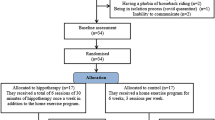Abstract
The objective of the present study is to quantify the position of the Centre of Mass (COM) during quiet standing using a force plate and compare this technique to the quantification of the COM with an anthropometric model. The postural control of 18 healthy adolescents and 22 IS patients was evaluated using an Optotrak 3D kinematic system, and two AMTI force plates during quiet standing. The position of anatomical landmarks tracked by the Optotrak system served to estimate the position of the COM of both groups using an anthropometric model (COManth). The force plate served to estimate the position of the COM through double integration of the horizontal ground reaction forces (COMgl). The mean position and root mean square (RMS) amplitude of COMgl, in reference to the base of support (BOS) and the first sacral prominence (S1) were quantified in the Anterior–Posterior (A/P) and Medial–Lateral (M/L) directions. There was a significant difference between the control subjects and IS patients for the displacement of the COMgl in reference to the BOS in both the A/P and M/L directions. There was no difference between groups for the mean position of the COMgl, however, 63% of the IS and 43% of the controls had a lateral position of the COMgl in reference to S1 of greater than 5 mm. There was a significant difference between groups in the A/P and M/L directions for the amplitude of error between the COMgl and COManth techniques.


Similar content being viewed by others
References
Benda BJ, Riley PO, Krebs DE (1994) Biomechanical relationship between center of gravity and centre of pressure during standing. IEEE Trans Rehabil Eng 2:3–10
Caron O, Faure B, Breniere Y (1997) Estimating the center of gravity of the body on the basis of the center of pressure in standing posture. J Biomech 30:1169–1171
Cook SD, Harding AF, Burke SW et al (1986) Upper extremity proprioception in idiopathic scoliosis. Clin Orthop 213:18–24
Corriveau H, Hébert R, Prince F et al (2001) Postural control in the elderly: an analysis of test-retest and interrater reliability of the COP–COM variable. Arch Phys Med Rehabil 82:80–85
Côté P, Kreitz BG, Cassidy JD et al (1998) A study of the diagnostic accuracy and reliability of the Scoliometer and Adam’s forward bend test. Spine 23:796–802
Dempster WT, Gaughran GRL (1967) Properties of body segments based on size and weight. Am J Anat 120:33–54
De la Huerta F, Leroux MA, Zabjek KF et al (1998) Stereovideographic evaluation of the postural geometry of healthy and scoliotic patients. Ann Chir 52:776–783
Guillaumat M, Lebard JP, Khouri N et al (1991) Scoliose Idioapthique en période de croissance. In: Encyclopédie médico-chirurgicale. Appareil Locomoteur. Editions Technique, Paris, pp 1–18
Halliday SE, Winter DA, Frank JS et al (1998) The initiation of gait in young, elderly, and Parkinson’s disease subjects. Gait Posture 8:8–14
Iwahara T, Imai M, Atsuta Y (1998) Quantification of cosmesis for patients affected by adolescent Idiopathic scoliosis. Eur Spine J 7:12–15
Jensen RK (1978) Estimation of the biomechanical properties of three body types using a photogrammetric method. J Biomech 11:349–358
Jensen RK (1986) Body segment mass, radius and radius of gyration proportions of children. J Biomech 19:359–368
Jensen RK (1989) Changes in segment inertia proportions between 4 and 20 years. J Biomech 22:529–536
Jensen GM, Wilson KB (1979) Horizontal postrotatory nystagmus response in female subjects with adolescent idiopathic scoliosis. Phys Ther 59:1226–1233
Jian Y, Winter DA, Ishac MG et al (1993) Trajectory of the body COG and COP during initiation and termination of gait. Gait Posture 1:9–22
Keessen W, Crowe A, Hearn M (1992) Proprioceptive accuracy in idiopathic scoliosis. Spine 17:149–155
King DL, Zatsiorsky VM (1997) Extracting gravity line displacement from stabilographic recordings. Gait Posture 6:27–38
Lenzi D, Cappello A, Chiari L (2003) Influence of body segment parameters and modeling assumptions on the estimate of center of mass trajectory. J Biomech 36:1335–1341
Lidstrom J, Friberg S, Lindstrom L, Sahlstrand T (1988) Postural control in siblings to scoliosis patients and scoliosis patients. Spine 13:1070–1074
Raso VJ, Lou E, Hill DL et al (1998) Trunk distortion in adolescent idiopathic scoliosis. J Pediatr Orthop 18:222–226
Reid JG (1984) Physical properties of the human trunk as determined by computed tomography. Arch Phys Med Rehabil 65:246–250
Sahlstrand T, Ortengren R, Nachemson A (1978) Postural equilibrium in adolescent idiopathic scoliosis. Acta Orthop Scand 49:354–365
Sahlstrand T, Petruson B, Ortengren R (1979) Vestibulospinal reflex activity in patients with adolescent idiopathic scoliosis. Postural effects during caloric labyrinthine stimulation recorded by stabilometry. Acta Orthop Scand 50:275–281
Stokes IA (1989) Axial rotation component of thoracic scoliosis. J Orthop Res 7:702–708
Stokes IA, Aronsson DD (2001) Disc and vertebral wedging in patients with progressive scoliosis. J Spinal Disord 14:317–322
Wever DJ, Veldhuizen AG, Klein JP et al (1999) A Biomechanical analysis of the vertebral and rib deformities in structural scoliosis. Eur Spine J 8:252–260
Winter DA, Patla AE, Rietdyk S et al (2001) Ankle muscle stiffness in the control of balance during quiet standing. J Neurophysiol 85:2630–2633
Winter DA, Patla AE, Prince F et al (1998) Stiffness control of balance in quiet standing. J Neurophysiol 80:1211–1221
Yeadon MR, Morlock M (1989) The appropriate use of regression equations for the estimation of segmental inertia parameters. J Biomech 22:683–689
Zatsiorsky VM, Duarte M (2000) Rambling and trembling in quiet standing. Motor Control 4:185–200
Zatsiorsky VM, King DL (1998) An algorithm for determining gravity line location from posturographic recordings. J Biomech 31:161–164
Acknowledgments
The Sick Children Foundation, NSERC, FRSQ and Sainte-Justine Hospital are acknowledged for their financial contribution in scholarship (KFZ, FP), and research grant (FP and CHR). Funding: Hospital For Sick-Childrens Foundation, Toronto, ON, Canada; Research Centre, Sainte-Justine Hospital, Montreal, QC, Canada
Author information
Authors and Affiliations
Corresponding author
Rights and permissions
About this article
Cite this article
Zabjek, K.F., Coillard, C., Rivard, CH. et al. Estimation of the centre of mass for the study of postural control in Idiopathic Scoliosis patients: a comparison of two techniques. Eur Spine J 17, 355–360 (2008). https://doi.org/10.1007/s00586-007-0568-7
Received:
Revised:
Accepted:
Published:
Issue Date:
DOI: https://doi.org/10.1007/s00586-007-0568-7




